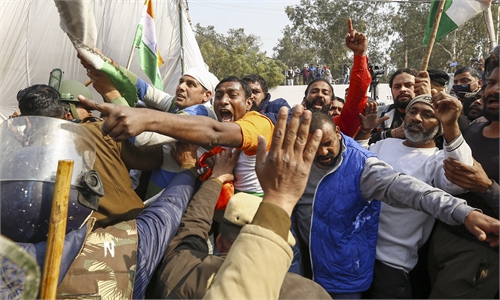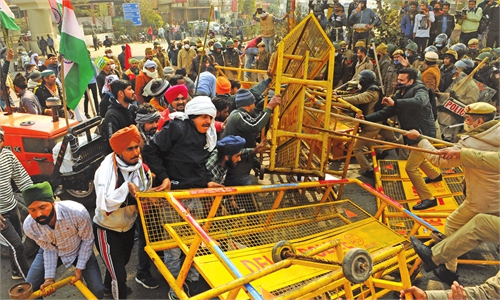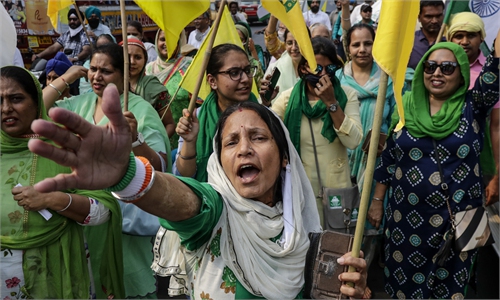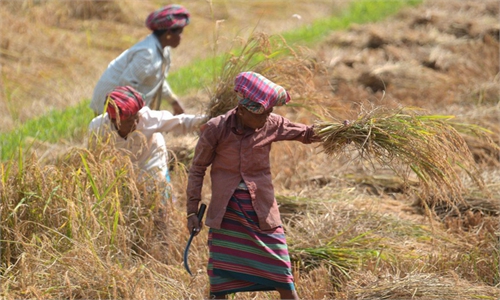Instead of boosting military muscles, India should compare with China on well-being of farmers

Farmers take part in a sit-in at Delhi Haryana Tikri Border in India, on Dec. 15, 2020. Thousands of farmers have been camping at several inter-state borders around Delhi, protesting against the three new farm laws enacted by the central government. Photo: Xinhua
Indian Prime Minister Narendra Modi announced on Friday that he will scrap three controversial agricultural laws that has resulted in Indian farmers' protest for almost an entire year. "Three farm laws to be rolled back, says PM Modi, urges farmers to leave protest sites," India Today reported Friday. "India's Modi backs down on farm reforms in surprise victory for protesters," reads a headline from Reuters on the same day. Yet is it a victory for either side? Not necessarily.India, home to roughly 898 million rural population, has witnessed farmers' outrage since November 26, 2020. Angry Indian farmers had choked traffic on major roads, railway tracks, and camped on the outskirts of New Delhi regardless of the ongoing public health crisis. The protests mushroomed as the country's economy was going through the worst recession since independence. Simultaneously, New Delhi seemed to have pinned all the focus on boosting the country's military muscle. "India has to boost military capabilities in line with changing mode of war," Indian news magazine The Week reported earlier this month.
Amid multiple challenges that the Modi administration are being confronted with, the farmers' crisis ended with the government taking a step back. But one can hardly claim this is a victory for Indian farmers, Xie Chao, an assistant professor at the Institute for International and Area Studies of Tsinghua University, told the Global Times.
Fuse and turning point
It started from new farming laws, passed in September 2020, which changed the way agriculture works in India. To put it simply, the Indian government used to offer guaranteed prices to farmers for certain crops. Yet the new laws minimize the government's role and encourage farmers to sell directly to buyers, or private investors. The price will be decided by the market.
Farmers have their own judgments about their interests when facing the new laws, and their judgment is different from that of the Modi administration. They believe their earnings will be devastated by ending guaranteed pricing and will have to sell their products to corporations at cheaper prices. After all, they are grass roots without money, information or social status. But they will have to deal with "almighty" capitalists directly.
Friday's announcement came as a surprise. Observers wonder why the Indian government, which has been firmly promoting the laws for a year, suddenly made a compromise. To some extent, the assembly elections in 2022 are an important factor.
Indian states are gearing up for assembly elections. Five of them will go to the polls in the first half of 2022, including Uttar Pradesh, Punjab and Uttarakhand, where agricultural productivity is high, farmers make up a crucial proportion of the vote bank and most of the protesters came from.
So Modi's rollback of the laws can be considered as the ruling Bharatiya Janata Party (BJP)'s move to ease pressure it faces and to stop lose in time, according to Xie. Northern states are the heartland of the ruling BJP. "If the party loses the elections there, the result will affect the big picture of BJP's ruling status," Xie noted.
Farmers' misery
About 750 farmers have died in the long-lasting protest over the past year. Clashes between farmers and police emerge every now and then. Reports show that a total of 10,677 people in the farming sector committed suicide in 2020.
Today, India is home to 17.3 percent of the world's population and 15.1 percent of world's undernourished population, according to United Nations World Food Programme. In March, Pew Research Center issued a report saying "the number of poor in India is projected to have reached 134 million, more than double the 59 million expected prior to the recession." In June, The Hindu noted, "So, India is again a 'country of mass poverty.'"
Most of the lands in India are in the hands of giant corporations and landlords, which also grasp most of the country's agricultural income and government subsidies. Tenant farmers, who are large in numbers but are at the bottom of social classes, mostly have very poor income and a hard life, according to Xie. When facing natural disasters, price fluctuations or burden of loans, they could get very vulnerable.
Indian politicians tend to voice particular emphasis in protecting farmers' interests during elections, both in parliamentary and local ones. Yet among many of their promises, only a small number of shortly fulfilled ones have benefited farmers' lives. Most others, especially medium- to long-term promises, often ended up being a mission impossible, observers find.
This may also be the case this time. After the BJP consolidates its status in India's local elections, it cannot be ruled out that more radical reforms will be introduced. And vulnerable groups, like farmers, will highly likely bear the costs of reforms, Xie noted.
Farmers vs military power
Although the Indian government wanted to modernize the country's agriculture industry through reforms, it is powerless to carry them out while guaranteeing that all farmers' interests will be protested.
Agricultural reform is indispensable in order to embark on the road to industrialization. Take China. When the country made strides toward the marketization of agriculture, it had built a modern industrial system in which agriculture integrated with industrial and service sector, with the emergence of more models and channels to sell agricultural products. The supply chain, including e-commerce platform, has been constantly improved. But so far, India is not yet capable to create more supporting industries and jobs.
In China, there is compulsory education for everyone, including those in rural areas. In India, however, apart from the fact that most of the farmers are poorly educated, compulsory education like China's can hardly be fully realized, observers noted.
"India's economy contracted 7.3 percent in 2020-21… its worst recession since independence" AFP reported in June. Yet at a time when it needs to hear the voices of the grass roots the most, New Delhi is busy carrying out sea trials of its aircraft carrier, parading fighter jets, launching missiles tests, purchasing weapons from different countries and getting growingly tough on border issues.
India has a great power dream. But India has so many places to spend money at home. Improving people's livelihood is a more rigid need than buying weapons. Unfortunately, the government seems to be overwhelmed by its illusions over "national security."
In terms of national development, at this moment, making real efforts in recovering the economy and boosting people's living standards is without doubt more efficient than piling up armed forces on its borders. Before boosting military muscles, India may as well compete with China on the fair treatment of its farmers first.
The author is a reporter with the Global Times. opinion@globaltimes.com.cn




